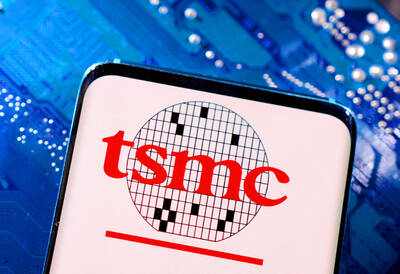AU Optronics Corp (友達光電), the world’s third-largest liquid-crystal-display (LCD) panel maker, yesterday said it planned to quadruple output at its 8.5-generation (8.5G) fab before the end of the year to meet a rapid across-the-board rise in demand.
The announcement follows the company’s comment two weeks ago that it did not see any “unfavorable factors” to the LCD industry in the second half of the year, helped by the seasonal computer shopping spree in the third quarter and Chinese buying ahead of the Lunar New Year in the fourth quarter.
AU Optronics said it would be able to supply only 80 percent of customer demand this quarter, which could drive up average selling prices by between 5 percent and 10 percent in the July-to-September period.

PHOTO: CHRIS TZOU, BLOOMBERG
To alleviate the shortage, AU Optronics chief executive Chen Lai-juh (陳來助) said the company “hopes to increase output as soon as it can.”
Average equipment utilization is approaching full usage, Chen said.
On June 23, the company hiked its target capital spending for this year to NT$75 billion (US$2.3 billion), from its previous estimate of NT$60 billion.
The company plans to increase output at its advanced 8.5G fab to full capacity, or 40,000 sheets of glass substrates per month, by the end of the year, compared with 10,000 sheets now
The 8.5G fab in Taichung processes bigger glass substrates, which can be cut into six sheets of 52-inch panels for LCD TV, or eight sheets of 46-inch panels.
AU Optronics also raised its forecast of global LCD TV demand by 14 percent to 125 million units, from its previous estimate of 110 million units, because of faster replacement of bulky cathode-ray-tube TVs and older LCD TV models.
Demand comes primarily from emerging markets such as China, India and Iran, company chairman Lee Kun-yao (李焜耀) told reporters yesterday.
The company is also evaluating the possibility of building a panel production line in China to be closer to customers and save on a potential rise in tariffs on LCD display modules.
Taiwanese panel makers are only allowed to assemble LCD modules in China, but the Beijing government is reviewing a longstanding ban on manufacturing LCD panels to help Taiwanese firms fend off competition from South Korean rivals.
Shares of AU Optronics fell 0.82 percent to NT$36.50 yesterday, outpacing the benchmark TAIEX, which lost 1.43 percent.

When Lika Megreladze was a child, life in her native western Georgian region of Guria revolved around tea. Her mother worked for decades as a scientist at the Soviet Union’s Institute of Tea and Subtropical Crops in the village of Anaseuli, Georgia, perfecting cultivation methods for a Georgian tea industry that supplied the bulk of the vast communist state’s brews. “When I was a child, this was only my mum’s workplace. Only later I realized that it was something big,” she said. Now, the institute lies abandoned. Yellowed papers are strewn around its decaying corridors, and a statue of Soviet founder Vladimir Lenin

UNCERTAINTIES: Exports surged 34.1% and private investment grew 7.03% to outpace expectations in the first half, although US tariffs could stall momentum The Chung-Hua Institution for Economic Research (CIER, 中華經濟研究院) yesterday raised its GDP growth forecast to 3.05 percent this year on a robust first-half performance, but warned that US tariff threats and external uncertainty could stall momentum in the second half of the year. “The first half proved exceptionally strong, allowing room for optimism,” CIER president Lien Hsien-ming (連賢明) said. “But the growth momentum may slow moving forward due to US tariffs.” The tariff threat poses definite downside risks, although the scale of the impact remains unclear given the unpredictability of US President Donald Trump’s policies, Lien said. Despite the headwinds, Taiwan is likely

UNIFYING OPPOSITION: Numerous companies have registered complaints over the potential levies, bringing together rival automakers in voicing their reservations US President Donald Trump is readying plans for industry-specific tariffs to kick in alongside his country-by-country duties in two weeks, ramping up his push to reshape the US’ standing in the global trading system by penalizing purchases from abroad. Administration officials could release details of Trump’s planned 50 percent duty on copper in the days before they are set to take effect on Friday next week, a person familiar with the matter said. That is the same date Trump’s “reciprocal” levies on products from more than 100 nations are slated to begin. Trump on Tuesday said that he is likely to impose tariffs

Taiwan Semiconductor Manufacturing Co’s (TSMC, 台積電) market value closed above US$1 trillion for the first time in Taipei last week, with a raised sales forecast driven by robust artificial intelligence (AI) demand. TSMC saw its Taiwanese shares climb to a record high on Friday, a near 50 percent rise from an April low. That has made it the first Asian stock worth more than US$1 trillion, since PetroChina Co (中國石油天然氣) briefly reached the milestone in 2007. As investors turned calm after their aggressive buying on Friday, amid optimism over the chipmaker’s business outlook, TSMC lost 0.43 percent to close at NT$1,150